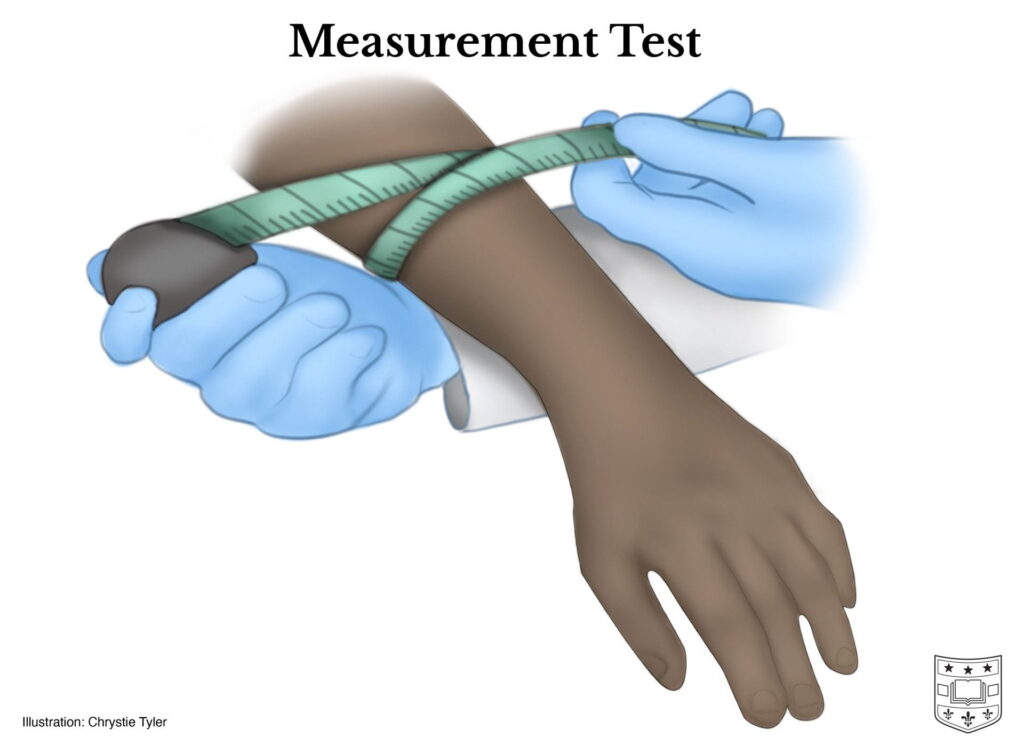Lymphedema is a long-term condition that results from the obstruction or damage of lymphatic vessels or lymph nodes. This obstruction or damage causes lymph fluid to build up in affected parts of the body. Swelling, skin changes and other chronic health problems can progress if the condition goes untreated. Common causes of lymphedema include cancer, cancer treatment or trauma that reduce the effectiveness of lymphatic drainage. A physician is responsible for diagnosing lymphedema and creating a management program for the patient to control the swelling and discomfort common for this condition. Dr. Sacks and Dr. Anolik are members of the Division of Plastic and Reconstructive Surgery at Washington University School of Medicine, in which lymphedema treatment is one of ten clinical programs.
On this page:
Lymphedema Diagnosis and Treatment: Frequently Asked Questions
How is lymphedema diagnosed?
A doctor’s examination is the first step of diagnosing lymphedema. Patient medical history is examined to understand how past surgeries or other health problems may have contributed to the onset of lymphedema. Measurements are taken of the affected area to compare with unaffected limbs and determine if there is a significant size difference. For example, if one arm or leg is over an inch larger than the other, it is likely that lymphedema is present in the swollen limb.

A doctor may also recommend tests that determine the cause of the lymph fluid build-up. One specific test is a lymphoscintigraphy, which uses radioactive markers, or radiotracers, to visualize blocked lymphatic vessels or lymph nodes. The radiotracers are tracked through the tested area of the body using special cameras and computers that create images of the lymphatic system. CT scans and MRI can also take images of the swollen body part to determine the source of the blockage. Other tests may also be performed to see if blood clots are causing the swelling.
Is there a cure to lymphedema? How can you treat it without surgery?
There is currently no cure for lymphedema, so treatment options are chosen to prevent and reduce swelling and other symptoms. Treatment options vary depending on the cause and stage of lymphedema. Options include:
- Exercising: The patient can reduce swelling through movement, which assists the drainage of lymph fluid. Aerobic exercise that does not exacerbate strain or discomfort is recommended in 20-30 minute sessions, five to seven days a week.
- Compression: A compression garment that remains tight around the affected area will prevent further swelling and encourage the lymph fluid to flow out.
- Massage therapy: Manual lymph drainage (MLD) massages can push the lymph fluid out of the tissue it has settled in, providing relief from swelling.
- Pneumatic pump: This pump is placed on the arm or leg with lymphedema, inflating to help lymph fluid flow out.
- Cancer treatment: If lymphedema is caused by a cancerous tumor blocking the lymphatic system, treating the cancer will decrease the impact of lymphedema.

What surgical treatments are available for lymphedema?
Surgery makes compressive garments less necessary and reduces the potential for developing infections of the soft tissue. Several surgical options are available for severe lymphedema, such as those in stages 3 or 4:
- Lymphatic bypass or lymphaticovenous anastomosis: In this procedure, lymphatic vessels are routed around obstructions to promote lymph fluid drainage. This can be a minimally invasive out-patient procedure.
- Vascularized lymph node transfer: Lymph nodes are taken from unaffected parts of the body and placed into areas where the lymphatic system is damaged and causing lymphedema.
- Liposuction: Liposuction treatment removes fat and soft tissues through a small incision, reducing overall mass in the region.
- Debulking, or Charles procedure: This surgery removes skin, fat and other soft tissue before covering the affected limb with a skin graft. Debulking is the most invasive procedure, only done in very extreme and advanced cases of lymphedema (stage 4) that have not responded to other therapeutic options.
Treating the complications of lymphedema, like infections or pain, is also important. Antibiotics and pain relief medication are commonly prescribed to relieve these complications.

What is lymphedema therapy?
Lymphedema therapy is the program of treatment prescribed by a lymphedema therapist, who is a specialist trained to help patients maintain their condition. Common treatments in lymphedema therapy include or combine exercise, compression garments or bandaging and MLD massages.
Who treats lymphedema?
Different experts will be involved in the treatment of lymphedema. Lymphedema therapists are consulted to help direct nonsurgical interventions such as lifestyle and management programs for patients. Surgeons are involved in more severe cases to decrease health risks caused by advanced lymphedema. Surgeons responsible for these procedures are usually specialists in plastic and reconstructive surgery.
Washington University Lymphedema Experts
The team of Washington University surgeons, including Dr. Sacks and Dr. Anolik have built an advanced program for treating lymphedema and providing management services. Surgeons with the Division of Plastic and Reconstructive Surgery provide expert surgical care for patients with lymphedema. They collaborate with radiology, medicine, and occupational and physical therapy teams. Lymphedema surgeons and therapists see patients at the Center for Advanced Medicine and Barnes-Jewish West County Hospital.
For more information about lymphedema treatment or to make an appointment with Dr. Sacks or Dr. Anolik at the Center for Advanced Medicine or Barnes-Jewish West County Hospital, please call 314-362-7388.
Learn more about the Division of Plastic and Reconstructive Surgery at plasticsurgery.wustl.edu.
